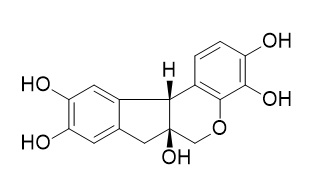Hematoxylin
Hematoxylin and eosin (H+E) are pigments, they are used to morphological assessment.
Inquire / Order:
manager@chemfaces.com
Technical Inquiries:
service@chemfaces.com
Tel:
+86-27-84237783
Fax:
+86-27-84254680
Address:
1 Building, No. 83, CheCheng Rd., Wuhan Economic and Technological Development Zone, Wuhan, Hubei 430056, PRC
Providing storage is as stated on the product vial and the vial is kept tightly sealed, the product can be stored for up to
24 months(2-8C).
Wherever possible, you should prepare and use solutions on the same day. However, if you need to make up stock solutions in advance, we recommend that you store the solution as aliquots in tightly sealed vials at -20C. Generally, these will be useable for up to two weeks. Before use, and prior to opening the vial we recommend that you allow your product to equilibrate to room temperature for at least 1 hour.
Need more advice on solubility, usage and handling? Please email to: service@chemfaces.com
The packaging of the product may have turned upside down during transportation, resulting in the natural compounds adhering to the neck or cap of the vial. take the vial out of its packaging and gently shake to let the compounds fall to the bottom of the vial. for liquid products, centrifuge at 200-500 RPM to gather the liquid at the bottom of the vial. try to avoid loss or contamination during handling.
Pharmaceutics.2021, 13(7):1028.
Molecules.2020, 25(11):2599.
iScience.2023, 26(9):107602.
Biomed Pharmacother.2024, 181:117658.
J Neuroinflammation.2020, 17(1):75.
Pharm Biomed Res2023, 9(3):173-182.
Advances in Traditional Medicine 2021, 21:779-789.
Br J Pharmacol.2016, 173(2):396-410
Saudi Pharm J2020, 10.1016
Int J Mol Sci. 2014, 15(5):8443-57
Related and Featured Products
Stroke. 1993 Jan;24(1):117-21.
Effect of brain edema on infarct volume in a focal cerebral ischemia model in rats.[Pubmed:
8418534]
Infarct volume is one of the common indexes for assessing the extent of ischemic brain injury following focal cerebral ischemia. Accuracy in the measurement of infarct volume is compounded by postischemic brain edema that may increase brain volume in the infarcted region. We evaluated the effect of brain edema on infarct volume determined by triphenyltetrazolium chloride and Hematoxylin and eosin stains in a focal cerebral ischemia model in rats.
METHODS AND RESULTS:
In a middle cerebral artery occlusion model in rats, infarction is confined to the cerebral cortex. The infarct was delineated by triphenyltetrazolium chloride stain and, in selected samples, by Hematoxylin and eosin stain. We determined infarct size at different times after the ischemic insult (6 hours to 7 days) in relation to the evolution of brain edema by the direct measurement of infarct volume. Indirect measurement to reduce the effect of edema on infarct volume was also conducted in the same brain samples.
Direct measurement showed that infarct volume fluctuated with the evolution of brain edema (one-way analysis of variance, p < 0.0001). Infarct volume determined by indirect measurement was independent of the extent of brain edema and remained stable from 6 hours to 3 days after ischemia. There was a good correlation between triphenyltetrazolium chloride and Hematoxylin and eosin stains in delineating infarct volume with both direct and indirect measurement.
CONCLUSIONS:
Traditional direct measurement of infarct volume is associated with an overestimation of infarct volume during the development of brain edema in the first 3 days after ischemia. This artifact can be reduced with indirect measurement, which is based on noninfarcted cortex volume.



